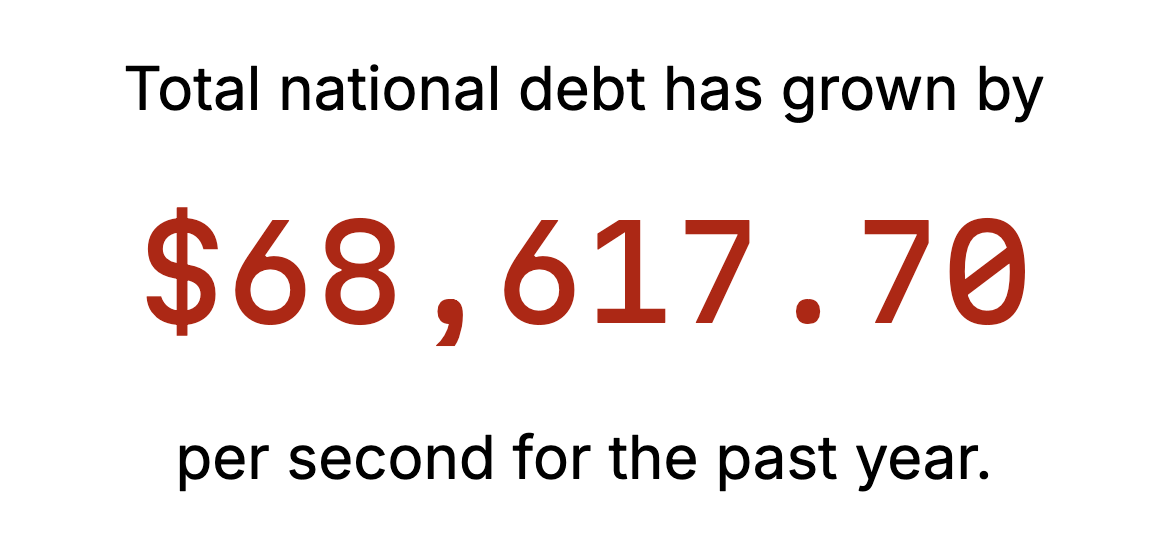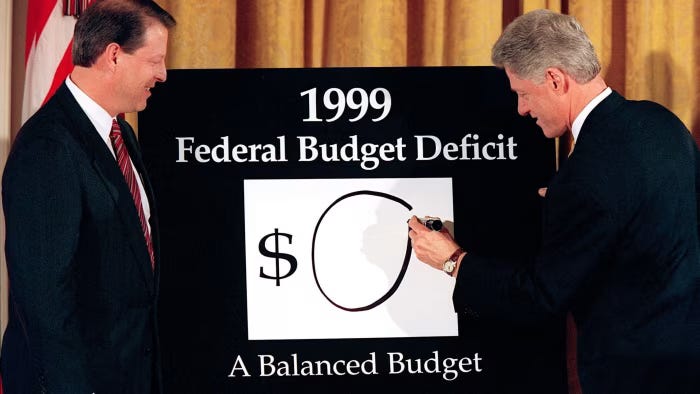Elon Musk's DOGE Has Been A Spectacular Failure
Republicans promised to fix the debt. They made it worse.
The scoreboard
Through August 2025, the federal deficit sits at $1.973 trillion on $6.664 trillion in outlays—about 29.6% of what we’ve spent is borrowed. Call it roughly one out of every 3 dollars.
The national debt is $37.47 trillion as of September 25. For scale: every individual American’s income combined is about $26.3 trillion, so even if every one of us donated every dollar we earned for a year, it still wouldn’t clear the tab.
Thanks to this big debt, we are now spending on the order of $1 trillion a year just on interest, more than Medicaid and more than the military.
So yes, the debt is a crisis. And, unfortunately, no, it’s not getting better on the current path.
Social Security goes bust in 2033. Medicare, later that same year. That means more borrowing to fill the gaps, or catastrophic cuts. Either timeline is bad.
How Republicans made it worse
The “Big, Beautiful Bill” that passed on July 4 blows a multi-trillion-dollar hole in the 10-year outlook for the budget—worse once you add the higher interest costs from bigger deficits.
Then came the sledgehammer to high-skill immigration: a $100,000 fee on each new H-1B petition, effective just over a week ago. High-skilled immigrants are large net taxpayers that we’ve relied on to stabilize government budgets. Now that they’re gone, the budget hole is even bigger.
Trump’s erraticness hasn’t helped. After liberation day, interest rates on the debt spiked.
Now, credit raters, including Moody’s, have downgraded the U.S. debt, citing decreasing confidence in the trustworthiness of the Federal Government.
The spiral we’re flirting with
Thanks to all this bad stuff, we are increasingly approaching an unsustainable debt spiral, which looks something like this:
Higher interest → bigger deficit → more borrowing → investors demand a risk premium → higher interest again.
That’s the doom loop. And if we go down it for long enough, eventually the debt will get so high that the US Government either has to declare bankruptcy or has to hyper-inflate our currency.
Either would result in global economic armageddon, the likes of which have not been seen since the Great Depression.
What DOGE actually did
This is the future DOGE promised to save us from. Instead of fixing the trajectory, it cooked the books.
DOGE touts big savings, but every serious review exposes its dishonesty. POLITICO verified about $1.4B out of $32.7B in specific “savings” claims—ceiling values counted as cash, triple-counting, and cancellations that don’t reduce the deficit unless Congress rescinds the funds.
For the minuscule savings, we’ve received:
Administrative wreckage. Shock layoffs and system freezes jammed core services. (Anecdote: Medicare randomly “enrolled” me; my insurer spent days trying to unwind it. Now imagine that error rate multiplied by millions.)
Scientific whiplash. NIH/NSF freezes knocked labs off cliffs mid-experiment. Judges are now ordering hundreds of millions restored to universities—after months of lost time and teams. And who knows how the Supreme Court will eventually rule on this?
USAID carnage. Aid freezes and attempted shutdowns pushed real human consequences; UN experts now estimate 350,000+ avoidable deaths already, with peer-reviewed modeling warning of millions by 2030 if cuts persist.
And all this for what? Savings that barely exist—and that are swamped by the costs of higher interest, lower growth, and chaos.
What now
The debt problem we face is hard, boring, and math-heavy. But it’s real.
It might not be the sexiest issue, but it threatens the economic future of every American—especially young people.
For years, Republicans have campaigned on the debt, promising they would save us from this problem. They didn’t. The last president to balance the budget was Bill Clinton.
Since then, every Republican has left deficits higher than they found them; every Democrat has left them lower.
The debt is fixable. The government currently gives away over $1.5 trillion a year in special tax breaks, exclusions, loopholes, and benefits. Corporate welfare costs over $100 billion a year. Waste, fraud, abuse, and corruption exist—and in many places they’re getting worse.
The financial problems of our government are not unsolvable, and they do not require further impoverishing the needy (as many Republicans claim).
However, change requires caring—caring about the American people and their economic future.
The Republican Party, despite all their rhetoric, does not care. And the American people deserve to know that.
This article was written by Lead Policy Advisor for Mockler Media, Micah Erfan.
Find his socials below:





Thank you so much for your article. It explains thoroughly the situation in a very comprehensive way.
I'm from Switzerland and follow you guys on a dayly basé.
Keep up the good job 💙💙💙💙💙
Failure!! Oh my God!! They got rid of all those people so Cockwomble could have that money to ‘play’ with. There were so many other ways to save besides getting rid of skilled workers.